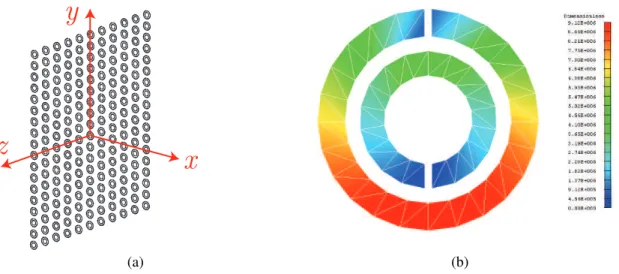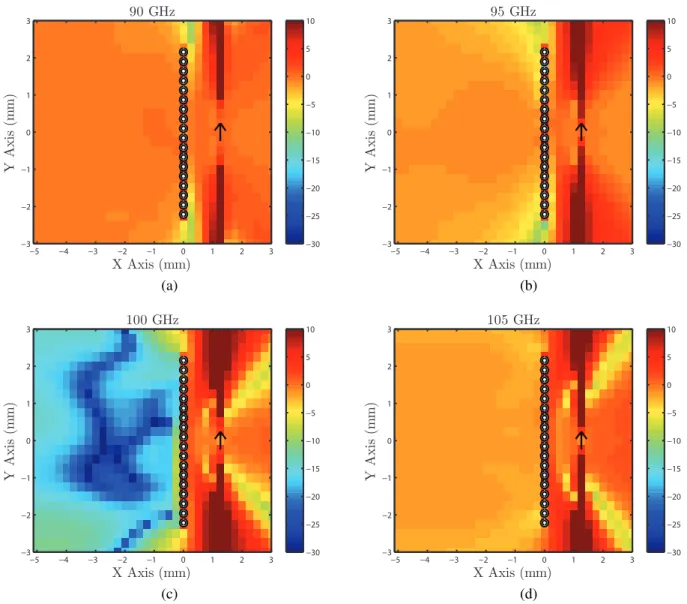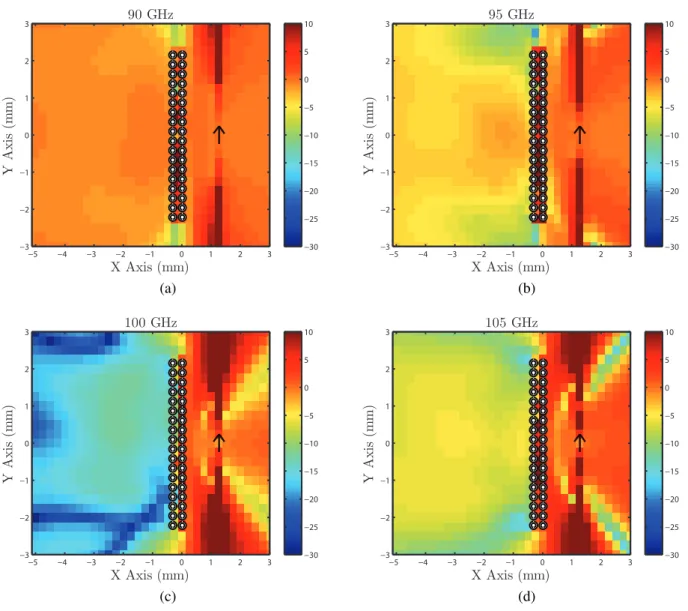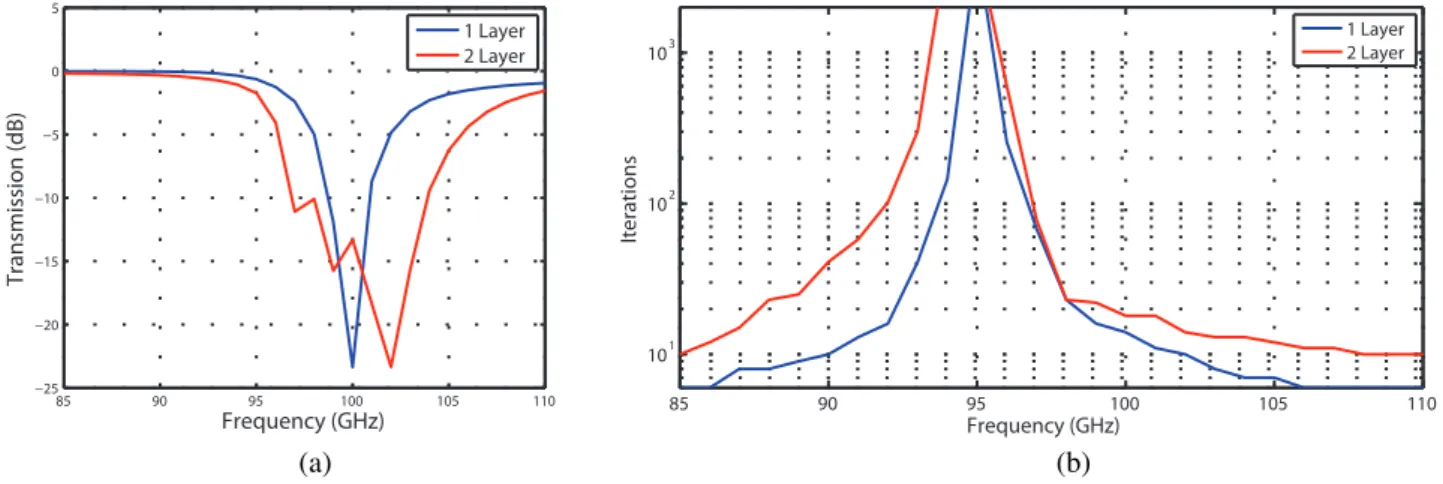Email: ergul@ee.bilkent.edu.tr, runal@ug.bilkent.edu.tr, lgurel@bilkent.edu.tr
ABSTRACT
Electromagnetic modelling of large metamaterial (MM) structures employing multilevel fast multipole algorithm (MLFMA) is reported. MMs are usually constructed by periodically embedding unit cells, such as split-ring res-onators (SRRs), into a host medium. Without utilizing any homogenization techniques, we accurately model large numbers of unit cells that translate into very large computational problems. By considering all of the elec-tromagnetic interactions, the resulting dense matrix equa-tions are solved iteratively with the accelerated matrix-vector products by MLFMA. To increase the efficiency, we also employ parallel computing in the solutions of large SRR problems.
Key words: Metamaterials; split-ring resonator; multi-level fast multipole algorithm.
1. INTRODUCTION
Since they were first proposed theoretically by Veselago in 1968 [1], metamaterials (MMs) have attracted a great amount of interest because of their unusual electromag-netic properties. MMs are usually constructed by period-ically embedding unit cells, such as split-ring resonators (SRRs), into a host medium. In this paper, we specifically investigate the MM structures consisting of a single layer or multiple layers, each of which is an array of SRRs as depicted in Fig. 1(a). In our modelling and simulations, we take into account that these structures actually have fi-nite extent and they exhibit interface properties. Without using homogenization, we accurately model large num-bers of SRRs to understand the scattering and transmis-sion properties of these structures. Accurate modelling and fast solution of these three-dimensional structures translate into very large computational problems, which can be solved with the aid of advanced acceleration tech-niques, such as the multilevel fast multipole algorithm (MLFMA) [2].
In this work, unit cell dimensions of the SRRs are in the order of microns to obtain an effective permeability around 100 GHz [3]. Around the resonance frequency, the transmission through the array is expected to decrease significantly due to the negative effective permeability stimulated in the medium. Dimensions of a single SRR depicted in Fig. 1(b) are as follows: The smaller ring has 43 µm inner radius and 67.2 µm outer radius, the larger ring has 80.7 µm inner radius and 107.5 µm outer radius, and the gap width is 7.2 µm. Single-layer SRR array in Fig. 1(a) is obtained by the arrangement of 11×18 SRRs. In this paper, we present the electromagnetic simulations of 1-layer and 2-layer SRR arrays.
2. INTEGRAL-EQUATION SOLUTIONS OF SRR STRUCTURES BY MLFMA
For the accurate simulations of MMs constructed by SRRs, we employ the electric-field integral equation (EFIE) to formulate the electromagnetic problem. For conducting surfaces, EFIE can be written in phasor nota-tion with the e−iwtconvention as
ˆ t · Z S dr0J(r0) ·³I −∇∇0 k2 ´ g(r, r0) = i kηt · Eˆ i(r) (1) directly from the boundary condition for the tangential electric field, where k and η are the wavenumber and wave impedance associated with the host medium. In our simulations, we assume that the relative permittivity of the host medium is 4.8, as it is commonly used in ex-perimental setups [3]. In (1), scattered electric field is expressed in terms of the induced (unknown) surface cur-rent J(r) with the aid of the free-space Green’s function
g(r, r0) = eikR
4πR ³
R = |r − r0|´, (2)
where r is an observation point on the surface, and ˆt is the tangential vector at the observation point. On the right-hand side of (1), Ei(r) denotes the incident electric field.
_____________________________________________________ Proc. ‘EuCAP 2006’, Nice, France
x
z
y
(a) (b)
Figure 1. (a) Single-layer SRR array obtained by the arrangement of 11×18 SRRs. (b) Induced surface current on a single SRR at 90 GHz.
As depicted in Fig. 1(b), SRRs are modelled by small triangles, on which Rao-Wilton-Glisson (RWG) [4] ba-sis functions are defined to expand the unknown current density induced on the metallic surfaces as
J(r) = N
X
n=1
anbn(r). (3)
In (3), an is the unknown coefficient of the nth basis
function and N is the number of unknowns. We perform a convergence analysis for the optimal discretization in terms of the accuracy and efficiency, leading to 84 trian-gular elements for a single SRR. Projection of EFIE in (1) onto RWG testing functions tm, leads to the matrix
equation N X n=1 ZmnE an= vmE, m = 1, ..., N, (4) where ZE mn= Z Sm drtm(r) · Z Sn dr0G(r, r0) · b n(r0) (5) for G(r, r0) =³I − ∇∇0 k2 ´ g(r, r0) (6)
represents the matrix element, and vE m= i kη Z Sm drtm(r) · Ei(r) (7)
represents the mth element of the excitation vector. In (5) and (7), Sm and Sn symbolize the spatial supports
of the mth testing and nth basis functions, respectively. Solving for the coefficients in (4), we obtain accurate rep-resentations for the induced surface currents as depicted in Fig 1(b) for a single SRR.
The matrix equation in (4) is solved iteratively, where the matrix-vector products are accelerated by MLFMA. The fundamental idea in MLFMA is to replace the element-to-element interactions with cluster-to-cluster interac-tions in a multilevel scheme. This computational scheme relies on the factorization of the Green’s function, which is valid only for basis and testing functions that are far from each other. For the far-field interactions, the matrix elements are derived as [5]
ZE mn= ik (4π)2 Z d2ˆkFE,rec Cm (ˆk)TL(k, D) · F E,rad C0n (ˆk), (8) where ˆk is the angular direction on the unit sphere and
TL(k, D) = L X l=0 il(2l + 1)h(1) l (kD)Pl( ˆD · ˆk) (9)
is the translation function written in terms of the spher-ical Hankel function of the first kind h(1)l and Legendre polynomial Pl.
In (8), FE,recCm represents the receiving pattern of the mth testing function with respect to a close point C. Similarly, FE,radC0n is the radiation pattern of the nth basis
function with respect to a close point C0. The
transla-tion functransla-tion in (9) evaluates the interactransla-tion between the basis and testing groups that are located at C0 and C,
respectively, and separated by
D = |D| ˆD = rC− rC0. (10)
By employing MLFMA, matrix-vector multiplications can be performed in O(N log N ) processing time us-ing O(N log N ) memory. In the iterative solutions of the scattering problems related to SRR structures, we
YA xi s( X Axis (mm) −5 −4 −3 −2 −1 0 1 2 3 −3 −2 −1 −30 −25 −20 −15 YA xi s( X Axis (mm) −5 −4 −3 −2 −1 0 1 2 3 −3 −2 −1 −30 −25 −20 −15 (a) (b) 100 GHz YA xi s( mm) X Axis (mm) −5 −4 −3 −2 −1 0 1 2 3 −3 −2 −1 0 1 2 3 −30 −25 −20 −15 −10 −5 0 5 10 105 GHz YA xi s( mm) X Axis (mm) −5 −4 −3 −2 −1 0 1 2 3 −3 −2 −1 0 1 2 3 −30 −25 −20 −15 −10 −5 0 5 10 (c) (d)
Figure 2. Power transmission for the 1-layer SRR array depicted in Fig. 1(a) at (a) 90 GHz, (b) 95 GHz, (c) 100 GHz, and (d) 105 GHz.
employ near-field preconditioner (NFP) to reduce the number of iterations. NFP is obtained by retaining all the near-field interactions of the problem. Although it is an expensive preconditioner, which has a higher complexity than MLFMA, the reduction in the processing time is significant for the solutions of SRR problems.
3. RESULTS
Fig. 2 presents the results for the 1-layer SRR array depicted in Fig. 1(a), where the power transmission is plotted at various frequencies. The transmission is cal-culated at different points in the z = 0 plane and the SRR array is depicted in the plots. The excitation is a Hertzian dipole oriented in the y direction as also indi-cated in the plots and the transmission region is on the left of the SRR array. At 90 GHz, 95 GHz, and 105 GHz, the power transmission through the SRR array is almost
unity, which corresponds to 0 decibels (dB). On the other hand, at the resonance frequency (100 GHz), the trans-mitted power drops dramatically due to the shadowing effect of the SRR array. In other words, the effective negative permeability introduced by the SRRs prevents the fields from passing into the transmission region. When the number of layers is doubled and we obtain a 2 × 18 × 11 array, the resulting power transmission is depicted in Fig. 3. In this case, we observe that the shadowing effect is not restricted to 100 GHz but instead extend from 95 GHz to 105 GHz. That is, the frequency region for the effective negative permeability gets wider for the 2-layer SRR array. We also select a location in the transmission region, which is the symmetric point of the location of Hertzian dipole with respect to the array, to present the power transmission as a function of fre-quency in Fig. 4(a). This way, we compare the 1-layer and 2-layer arrays and observe that the 2-layer array pro-vides a wider band for low transmission.
90 GHz YA xi s( mm) X Axis (mm) −5 −4 −3 −2 −1 0 1 2 3 −3 −2 −1 0 1 2 3 −30 −25 −20 −15 −10 −5 0 5 10 95 GHz YA xi s( mm) X Axis (mm) −5 −4 −3 −2 −1 0 1 2 3 −3 −2 −1 0 1 2 3 −30 −25 −20 −15 −10 −5 0 5 10 (a) (b) 100 GHz YA xi s( mm) X Axis (mm) −5 −4 −3 −2 −1 0 1 2 3 −3 −2 −1 0 1 2 3 −30 −25 −20 −15 −10 −5 0 5 10 105 GHz YA xi s( mm) X Axis (mm) −5 −4 −3 −2 −1 0 1 2 3 −3 −2 −1 0 1 2 3 −30 −25 −20 −15 −10 −5 0 5 10 (c) (d)
Figure 3. Power transmission for the 2×18×11 SRR array at (a) 90 GHz, (b) 95 GHz, (c) 100 GHz, and (d) 105 GHz.
Finally, Fig. 4(b) presents the number of iterations for the solutions of 1-layer and 2-layer SRR arrays with respect to frequency. These iterations are obtained when NFP is employed, which includes all the available interactions of MLFMA. We observe that there exists a numerical resonance at 95 GHz and the number of iterations ex-ceeds 2000. To obtain a convergence at these special frequencies, we reduce the number of levels of MLFMA and enrich the near-field matrix. For the SRR arrays with multiple layers, this strategy may fail to provide a so-lution with the existing computational resources. Then, we have to employ stronger and more efficient precondi-tioners based on advanced techniques, such as two-level preconditioning.
4. CONCLUSION
We report our efforts for accurate and efficient solutions of electromagnetic problems related to large MM struc-tures constructed by SRRs. We formulate the problem by EFIE and solve the resulting dense matrix equations iter-atively by MLFMA. In this paper, electromagnetic simu-lations of 1-layer and 2-layer SRR arrays are presented. Results for the larger number of layers will be included in the presentation.
ACKNOWLEDGMENTS
This work was supported by the Scientific and Techni-cal Research Council of Turkey (TUBITAK) under Re-search Grant 105E172, by the Turkish Academy of Sci-ences in the framework of the Young Scientist Award Pro-gram (LG/TUBA-GEBIP/2002-1-12), and by contracts from ASELSAN and SSM.
85 90 95 100 105 110 −25 −20 Frequency (GHz) Tr a 85 90 95 100 105 110 101 Frequency (GHz) (a) (b)
Figure 4. (a) Power transmission at a location in the transmission region, which is the symmetric point of the location of Hertzian dipole with respect to the array. (b) Iteration counts for the solutions of 1-layer and 2-layer SRR arrays. REFERENCES
[1] V. G. Veselago, “The electrodynamics of substances with simultaneously negative values of permittivity and permeability,” Sov. Phys. Usp., vol. 10, no. 4, pp. 509–514, Jan.-Feb. 1968.
[2] C.-C. Lu and W. C. Chew, “Multilevel fast multi-pole algorithm for electromagnetic scattering by large complex objects,” IEEE Trans. Antennas Propagat., vol. 45, no. 10, pp. 1488–1493, Oct. 1997.
[3] M. Gokkavas, K. G¨uven, I. Bulu, K. Aydın,
R. S. Penciu, M. Kafesaki, C. M. Soukoulis and E. ¨Ozbay, ”Experimental demonstration of a left-handed metamaterial operating at 100 GHz,” Phys. Rev. B., vol. 73, no. 193103, 2006.
[4] S. M. Rao, D. R. Wilton, and A. W. Glisson, “Elec-tromagnetic scattering by surfaces of arbitrary shape,” IEEE Trans. Antennas Propagat., vol. AP-30, no. 3, pp. 409–418, May 1982.
[5] W. C. Chew, J.-M. Jin, E. Michielssen, and J. Song, Fast and Efficient Algorithms in Computational Elec-tromagnetics. Boston, MA: Artech House, 2001.



